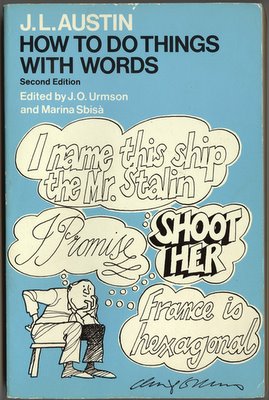
I sat in on three student papers and Ted Sider's keynote speech. I think I learned quite a bit from these talks.
I'll take them in order. (If I misrepresent what was said by anyone, which is probable, feel free to let me know and I'll try to fix it).
1. Mr. Wayne Wu (WW),
"...Conceptual Content..."Very roughly: WW argued that perceptual content was conceptual because certain psychological experiments suggest that semantic memory (which is conceptual) is involved in perceptually-guided tasks (like picking things up).
The Q&A session was enjoyable and packed with good, substantial questions. I was most interested in WW's criticism of "demonstrative" theories of intention, which he thought were unable to account for the amount and quality of information we receive when we perceive and successfully interact with objects. I had a question that I didn't get to ask because I didn't raise my hand soon enough, but it concerned whether WW was fair to demonstrative accounts (of perception or intention) when he characterized them as (1) committed to the idea that you can have a demonstrative thought about an object (or direct a demonstrative intention towards an object) so long as you can
spatially
locate the object, and (2) that you can locate an object (in this case, a hammer), by reaching out and touching a certain distinctive
part of it (the handle, say). WW said that because the demonstrative theorist is committed to saying that such a person could have demonstrative thoughts about the hammer, but may not be able to successfully pick it up (not knowing what part of the handle he's touching, or where the head is, or whether it is obstructed by something), the demonstrative theorist didn't have an adequate account of how perception contributes to successful action. But when WW went on to contrast his own account of how perception contributes to successful action, he imagined a situation in which a subject could see the
whole object that he intended to act on. But if one could only see a bit of the hammer (if it was protruding from under a couch, say), then one might very well have the same problem successfully picking it up. So I didn't think he really dispatched the demonstrative theorist, though I'm unsure of how important this is for the overall argument of his paper, which was enjoyable and provocative in many other respects.
2. Mr. Matthew Haug (MH),
"Is Multiple Realizability Necessary for Irreducibility?"MH gave a clear and well-reasoned argument that the answer to the question in his title is no. It is usually assumed that the multiple realizability of mental states in physical states is required for irreducibility. But MH wanted to suggest that another relation, the determinate-determinable property relation, gave us a way of seeing how mental properties are irreducible to their physical realizers. He said that the structure that realizes the mental property will be "multiply determinative", realizing many different mental properties, and so no 1-1 reduction of mental propeties to physical properties was possible. MH's paper was very clear and well presented. WW asked a question of MH's paper that I also was wondering about, namely, whether someone could respond to his paper by saying that the determinate mental properties are not all realized in the same physical "structure" (there was also some debate about the meaning and significance of "structure" in the paper), but by different, corresponding physical properties of the structure. Take, e.g., MH's example, "the structure of a cubical peg simultaneously realizes the peg's shape, color, mass, and rigidity". Mightn't one say that different elements of the structure realize the color, mass and rigidity of the peg?
3. Prof. Ted Sider, (TS),
"Ontological Realism"TS rocked the mic in front of a large gathering of philosophers in Exeter College's Saskatchewan room. He gave a fantastically clear and absorbing account of debates about the composition of objects. There was a great deal of interesting material in his paper, but what I found most interesting was a fertile methodlogical question he raised: what makes a dispute "merely verbal"? TS wanted to argue that debates about the composition of objects are not merely verbal, despite a common feeling that they are. I think it would be a productive project to look at other examples of someone claiming that something is a "merely verbal" dispute. The only example that immediately came to mind was Francois Recanti's charge in Direct Reference that the dispute between Evans/McDowell and various narrow content theorists over the role of mental content in action-explanation is merely verbal. (When I ran into Josef Stern this morning walking across the quad, he said that Hume says debates about god are merely verbal. If anyone knows of any other examples of philosophers (or members of the folk) saying that a debate is merely verbal or merely terminological, let me know.)
4. Mr. Daniel Whiting (DW),
"Meaning Theories and the Principle of Humanity"DW raised a concern about the modest meaning theories of McDowell and Wiggins. Here is my thumbnail version of the concern: if one aims merely to give a perspicuous overview of the way meaning, truth, force and psychological explanation interact, then why pursue that project by advocating a Davidsonian truth-theory for a language? Why begin the elucidatory project without helping oneself to the concept of meaning? I asked DW if he would agree with my feeling that if the goal of the modest theorists is to explore the way these important concepts are interdependent, then a project like J.L. Austin's might be more appropriate than a t-theory. He said that he thought that thinking about Austin's relevance to these kinds of questions was interesting.

 Sunnyside Drive-In, Fresno, CA, 2002.
Sunnyside Drive-In, Fresno, CA, 2002.
 (Thanks to Wyeth for the scan of the cover.)
(Thanks to Wyeth for the scan of the cover.)


 Merton Street.
Merton Street. Oriel Street.
Oriel Street. Magpie Lane.
Magpie Lane. Jowett Walk.
Jowett Walk.




